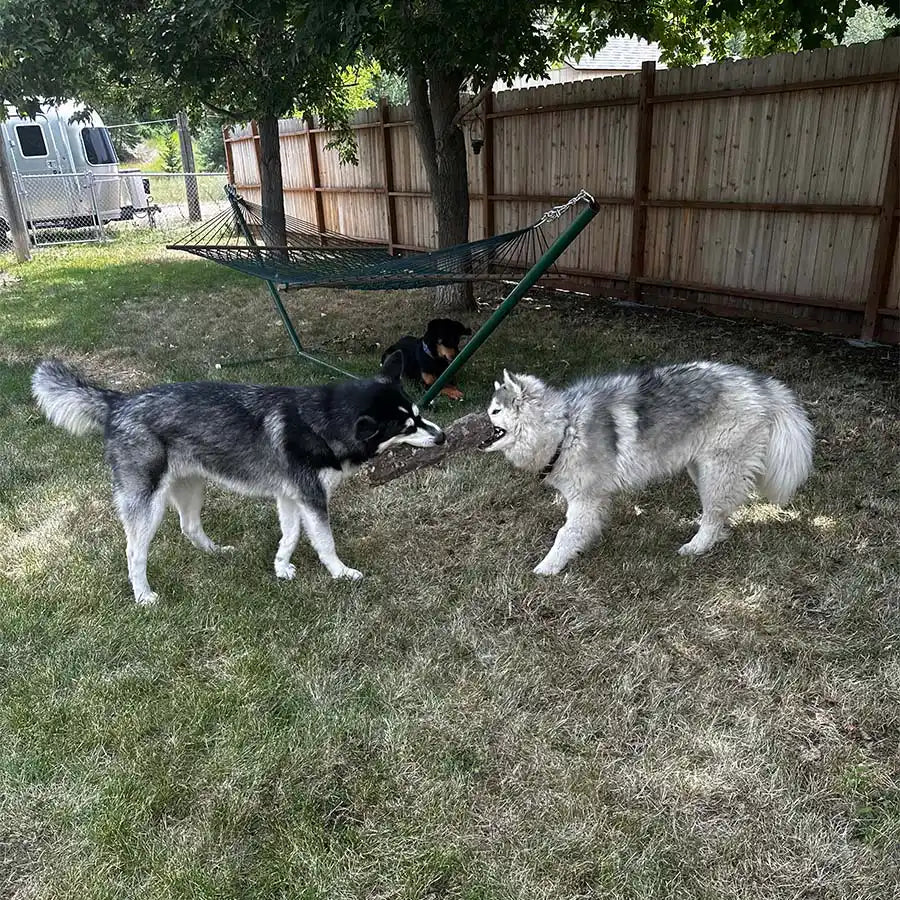
Safety is Our #1 Priority
When it comes to breaking up a dog fight at a dog daycare and boarding facility, the safety of both the dogs and the staff is the top priority. We monitor the dogs closely to catch a behavior before it gets out of hand and breaks into a fight. With our attentive staff preventing fights is something we are trained in and ready to do. We require dog temperament tests for new dogs to ensure the safety of everyone on the premises.
Here's an industry-standard protocol we follow:
Stay Calm and Assess the Situation:
Remain calm and composed. Assess the intensity of the fight and the number of dogs involved. Avoid panicking or yelling, as it may escalate the situation further.
2. Signal for Help:
Call for assistance immediately. Alert nearby staff members or colleagues to come and help. Having multiple staff members present can help manage the situation more effectively.
3. Use Noise or Distractions:
Try to divert the dogs' attention by making loud noises, using an airhorn, or clapping hands. Sometimes, a loud noise can startle the dogs and interrupt the fight.
4. Physical Intervention:
Physically grabbing the dogs during a fight, as this may lead to accidental bites or injuries. Using your hands to break up a fight can be dangerous and should be avoided unless absolutely necessary. Dog are grabbed by their hind legs to be thrown off balance.
5. Use Tools or Barriers:
If available, use tools like long poles, a large piece of cardboard, or a board to create a barrier between the fighting dogs. This can help separate them without risking physical contact. If a dog is gripped onto something this step may be necessary.
6. Utilize Water:
Water can be an effective way to disrupt a dog fight. Use a hose, water spray bottle, or a pet-friendly water deterrent spray to separate the dogs. Using a hose is the most effective method if a hose is nearby and easily assessed.
7. Be Mindful of Body Language:
Watch for signs of fear or submission from one or both dogs. If one dog shows signs of submission, it may be possible to safely remove the more aggressive dog from the area. Also, watching for signs of bullying or unwanted chasing are big items to be aware of.
8. Practice Restraint Techniques:
If necessary, consider using a leash or slip-lead to gain control of one of the dogs. Being cautious and ensuring we train on how to safely use these tools. Sperating dogs after a fight is necessary and they are moved to different fenced areas to ensure another fight doesn’t break out. This is a critical step. Depending on severity on fight, based on the Dunbar Bite Scale, dog(s) may be dismissed permanently from the facility.
9. Provide Medical Attention:
After the fight has been broken up, check all dogs involved for injuries. Administer first aid if needed and seek veterinary attention for any serious injuries.
10. Post-Incident Assessment:
After the incident, conduct a thorough evaluation of the factors that may have contributed to the fight. Identify any triggers or stressors to prevent similar situations in the future.
11. Document the Incident:
Record details of the incident, including the dogs involved, any injuries sustained, and actions taken. This documentation is crucial for internal purposes and may be needed for reporting to pet owners.
Breaking up a dog fight can be risky, and it's essential to prioritize safety. Staff members receive regular training in dog behavior and handling to prevent and manage potential conflicts effectively. We have clear protocols in place to ensure that everyone knows how to respond if a fight occurs, minimizing the risk of injuries and providing a safe environment for all dogs and humans at the facility.

